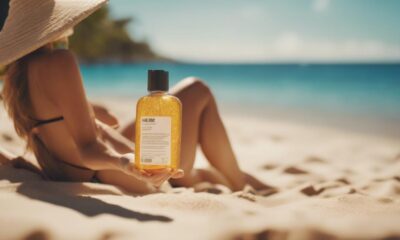Protecting Children
The Shocking Truth About Kids and Sunscreen: What You Need to Know
Catch the shocking truths about kids and sunscreen that every parent must know to protect their child's delicate skin effectively.
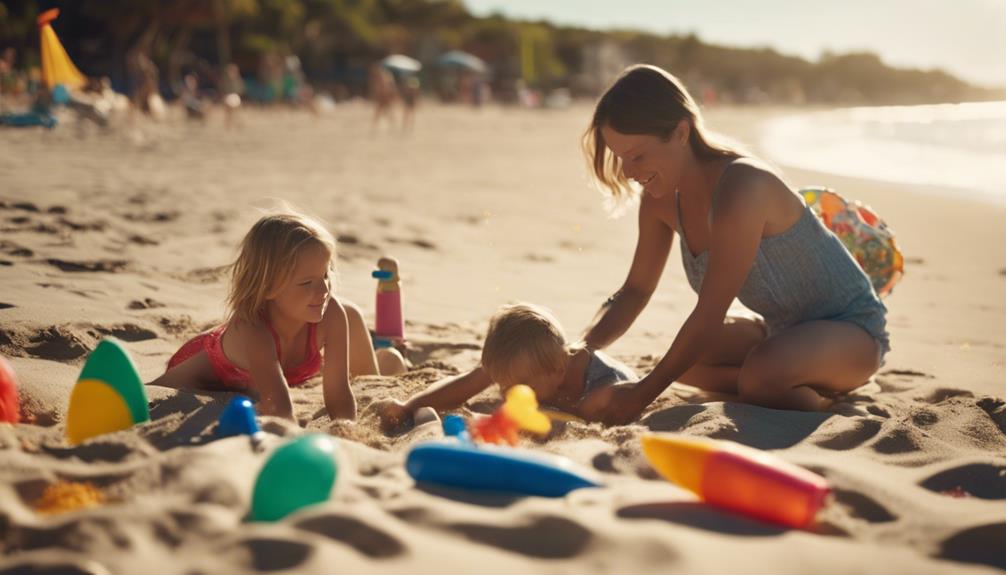
The shocking truth is that many parents overlook the serious risks of sun exposure for kids and often misuse sunscreen, jeopardizing their health. Children's skin is thinner, making them more susceptible to sunburns and long-term damage, like melanoma. You should prioritize mineral-based sunscreens, avoiding harmful chemicals that can disrupt hormones. It's vital to apply sunscreen daily, even on cloudy days, and reapply every two hours. Myths about sunscreen efficacy can lead to inadequate protection. Understanding these facts is essential for keeping your child safe in the sun, and there's much more to discover about proper sunscreen habits.
Key Takeaways
- Children's skin is thinner and more sensitive, making them more susceptible to sunburn and increasing their risk of melanoma later in life.
- Chemical sunscreens may contain endocrine disruptors and harmful ingredients, so mineral-based options are recommended for children's safety.
- Daily sunscreen application is crucial, even on cloudy days, as up to 80% of UV rays can penetrate clouds.
- One severe sunburn in childhood can double the risk of developing skin cancer later in life; early protection is essential.
Understanding Sunscreen Ingredients
When choosing sunscreen for your kids, it's crucial to understand the difference between chemical and physical ingredients. Chemical sunscreens absorb UV rays and often contain compounds like oxybenzone and avobenzone. While they may be effective, these ingredients can penetrate the skin and enter the bloodstream, raising safety concerns for your little ones.
On the other hand, mineral sunscreens, which include non-nano zinc oxide and titanium dioxide, sit on the surface of the skin and reflect UV rays away. This makes them a safer option for children, as they minimize the risk of absorption into the body.
When selecting a mineral sunscreen, look for formulations that avoid harmful ingredients like parabens, phthalates, and synthetic fragrances. These substances can cause skin irritation and hormonal disruptions, which you definitely want to avoid for your kids.
Additionally, consider choosing 'reef-safe' sunscreens that don't contain harmful chemicals like oxybenzone and octinoxate, which are known to damage marine ecosystems. By opting for mineral sunscreen, you're not only protecting your kids but also being mindful of the environment.
Importance of Year-Round Protection

Consistent sun protection is crucial year-round, as harmful UV rays can damage your child's skin even on cloudy or cool days. Many parents mistakenly believe that sunscreen isn't necessary when the sun isn't shining brightly, but up to 25% don't reapply sunscreen on those overcast days.
Remember, UVA rays penetrate clouds and can still cause significant skin damage. Moreover, reflective surfaces like sand and water can amplify UV exposure, increasing the need for ongoing protection. Your child needs the same sun safety precautions regardless of the weather to minimize the long-term skin cancer risk associated with UV exposure. It's important to understand that a considerable amount of UV exposure during childhood can lead to a heightened risk of skin cancers later in life.
Implementing sun safety measures, such as regular sunscreen application, is critical throughout the entire year. Don't wait for sunny days to think about protecting your child's skin. Make sun protection a daily habit, whether you're at the beach or simply playing outside.
Prioritize their skin health now, and you'll be helping to safeguard their future.
Safe Application Techniques

Applying sunscreen correctly is essential to guarantee your child's skin receives the maximum protection from harmful UV rays. Start by applying a generous amount—about one ounce, or the size of a shot glass—to all exposed skin areas. Don't forget commonly missed spots like ears, tops of feet, and the back of the neck.
For ideal absorption and effectiveness, make sure to apply sunscreen 15-30 minutes before sun exposure. Reapply every two hours, or more often if your child swims, sweats, or towels off. Remember, no sunscreen is truly waterproof.
When choosing a product, opt for mineral-based sunscreens containing non-nano zinc oxide or titanium dioxide. These provide effective physical protection without harmful chemicals.
If you're using spray sunscreens, rub the product into the skin after application to guarantee even coverage. Also, always apply sunscreen to dry skin for the best results.
Risks of Chemical Sunscreens
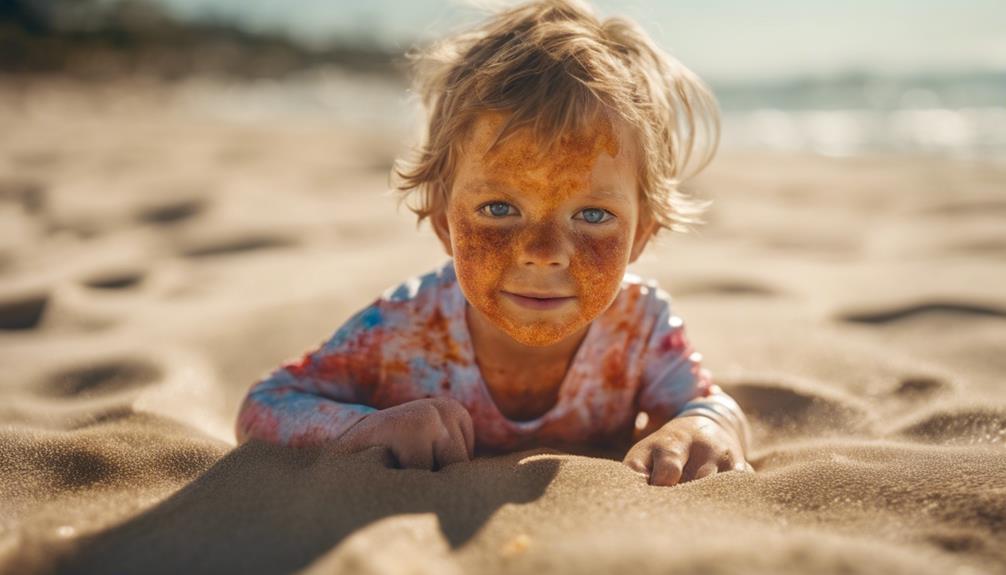
When you choose chemical sunscreens for your kids, you might be exposing them to endocrine disruptors linked to serious health issues.
These chemicals not only affect human health but also harm coral reefs, raising concerns about environmental impact.
It's essential to take into account both the risks to your children and the planet before applying these products.
Endocrine Disruption Risks
Many parents may not realize that chemical sunscreens can contain endocrine disruptors, which pose serious health risks for children. Ingredients like oxybenzone are linked to abnormal fetal development and early puberty. This can be particularly alarming for parents concerned about their children's growth and overall health.
Studies show that exposure to certain chemical sunscreen components may decrease fertility and lower sperm counts in males, raising concerns for future generations. Additionally, women using these products face an increased risk of developing breast and ovarian cancer due to harmful ingredients. Long-term usage of chemical sunscreens also raises questions about potential links to prostate cancer in men.
What's even more concerning is that chemical sunscreen ingredients can enter the bloodstream, urine, and even breast milk. This means that your child could experience systemic exposure to these hazardous chemicals, increasing their risk of harmful health effects.
As a responsible parent, it's essential to be aware of these risks and to evaluate alternatives, such as mineral-based sunscreens that don't contain harmful endocrine disruptors. Protecting your child's health starts with understanding what's in the products you choose.
Coral Reef Impact
Chemical sunscreens not only pose risks to children's health but also threaten coral reef ecosystems, with ingredients like oxybenzone contributing significantly to coral bleaching. Just a small amount—about 62 milligrams—can damage an entire square meter of coral reef. This is alarming when you consider that over 14,000 tons of harmful chemicals from sunscreens wash into the ocean each year during swimming activities.
Coral reefs are crucial habitats for countless marine species, and their decline due to chemical pollution can lead to significant biodiversity loss and disrupt marine food chains.
When you choose a sunscreen for your kids, it's important to be mindful of its environmental impact. Many regions now ban certain chemical sunscreens, promoting reef-safe options like mineral sunscreens, which use natural ingredients that don't harm marine life.
Myths About Sunscreen Efficacy

Numerous myths surround sunscreen efficacy, leading parents to underestimate the importance of proper application and reapplication. Understanding these misconceptions can help you protect your child's skin from damage.
- Higher SPF equals better protection – While it might seem logical, SPF 30 and SPF 50 only differ by about 1% in UVB blockage. Remember, reapplying sunscreen every two hours is more important than the SPF number you choose.
- Sunscreen isn't necessary on cloudy days – Up to 80% of UV rays can still penetrate clouds. Your child's skin can suffer damage even when it's overcast, so don't skip sunscreen.
- Water-resistant sunscreen lasts all day – Water-resistant doesn't mean waterproof. These sunscreens are only effective for 40 to 80 minutes in water, so you must reapply frequently after swimming.
Children's Skin and Sunburns
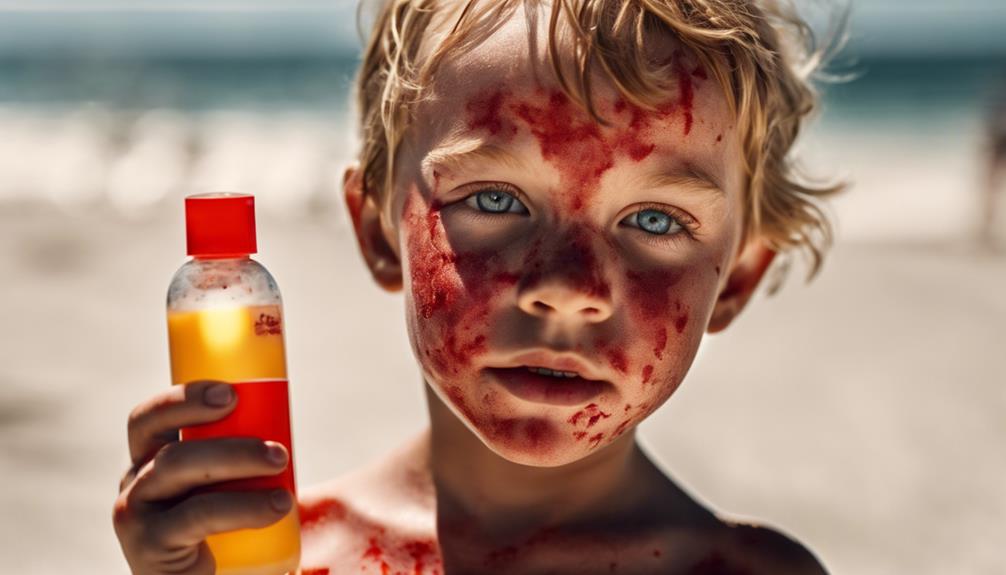
Children's skin is delicate and more prone to sunburn, which can lead to serious long-term consequences like skin cancer.
You need to prioritize SPF protection, even on cloudy days, as UV rays can still cause damage.
Understanding these risks helps guarantee your child's skin stays safe from harmful effects now and in the future.
Sunburn Risks for Children
Sunburn poses a serious risk for kids, as their delicate skin is more vulnerable to UV damage and can lead to long-term health consequences.
It's vital to understand the sunburn risks associated with childhood exposure. Just one severe sunburn can double the risk of developing melanoma later in life.
Here are three key points to reflect on:
- Children's skin is thinner and more sensitive, making them more susceptible to sunburns, particularly during peak sun hours (10 a.m. – 4 p.m.).
- 80% of a person's lifetime sun exposure occurs before the age of 18, highlighting the importance of effective sun protection during childhood.
- Awareness of the risks is alarmingly low, with only 32% of parents recognizing the link between childhood sunburns and increased skin cancer risk.
To protect your children, it's imperative to wear sunscreen every day, even on cloudy days or during winter months.
Make it a habit to reapply every two hours, or more often if they're swimming or sweating.
Importance of SPF
Using sunscreen with a high SPF is crucial for protecting delicate skin from harmful UV rays and preventing painful sunburns. Children's skin is thinner and more sensitive than adults', making them more vulnerable to UV damage.
Dermatologists recommend using a broad-spectrum sunscreen with an SPF of 30 or higher, as this effectively blocks both UVA and UVB rays. Even on cloudy days, up to 80% of UV rays can still reach your child's skin, which means applying sunscreen isn't just for sunny days.
A single sunburn in childhood can double the risk of developing melanoma later in life, highlighting the critical importance of consistent sun protection. To guarantee maximum protection, reapply sunscreen every two hours and immediately after your child swims or sweats.
Kids are often active, and their movements can wash away protective layers quickly, leaving them exposed to harmful UV rays. Remember, sun protection isn't a one-time task; it's a commitment you make to safeguard your child's skin and health.
Long-Term Skin Damage
Protecting young skin from the sun isn't just about preventing immediate pain; it's also essential for safeguarding against long-term damage that can impact their health for years to come. Childhood sunburns greatly increase the risk of developing melanoma and other skin cancers later in life. Remember, just one blistering sunburn can double this risk.
To truly understand the importance of protecting kids from the sun, consider these points:
- Thin Skin: Children's skin is thinner and more sensitive, making them more vulnerable to UV damage.
- Cumulative Damage: Repeated sun exposure leads to accumulated damage, which is a major factor in skin cancer development.
- Premature Aging: Even minimal UV exposure can result in premature aging and discoloration that may not show up until later in life.
It's alarming that only 32% of parents recognize the link between childhood sunburns and increased skin cancer risk.
You can make a difference by actively taking steps today to protect your kids from the sun, ensuring their skin remains healthy and resilient for the future.
Choosing the Right Sunscreen
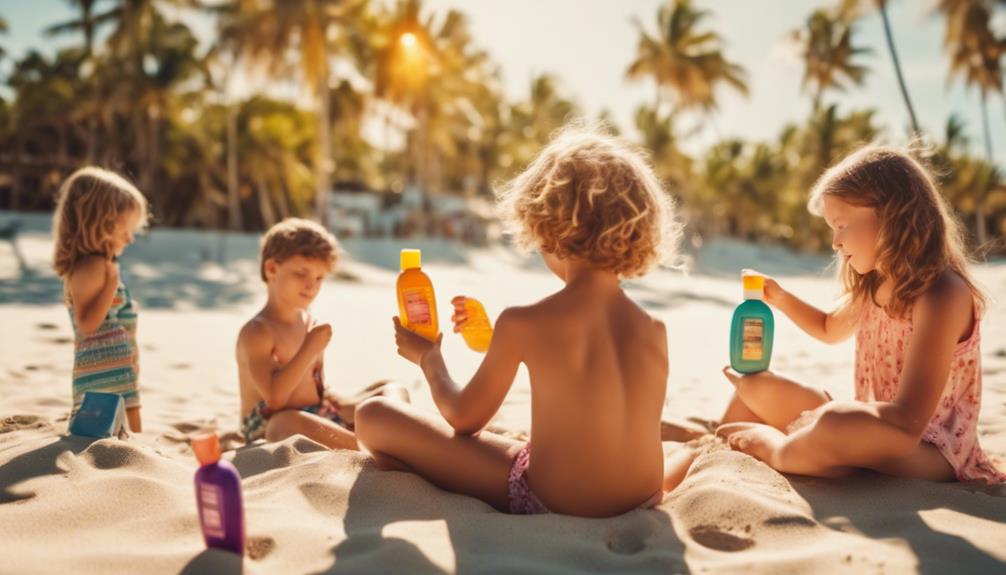
Selecting the right sunscreen for your child involves choosing mineral-based options that effectively block harmful UV rays while being gentle on their skin. Look for formulations containing non-nano zinc oxide or titanium dioxide, as these ingredients physically shield against UV radiation without the use of harsh chemicals.
Aim for a sunscreen with an SPF of 50 or higher to provide ideal protection against UVB rays, which are known to cause sunburn.
When shopping, check for 'reef-safe' labels to guarantee the product won't harm marine ecosystems.
Avoid spray formulations for young children, as they pose inhalation risks; creams or lotions allow for more controlled application and coverage.
Always scrutinize ingredient lists to confirm the sunscreen is free from parabens, phthalates, and synthetic fragrances, which can irritate sensitive skin or disrupt hormones.
Incorporating Sunscreen Into Routine
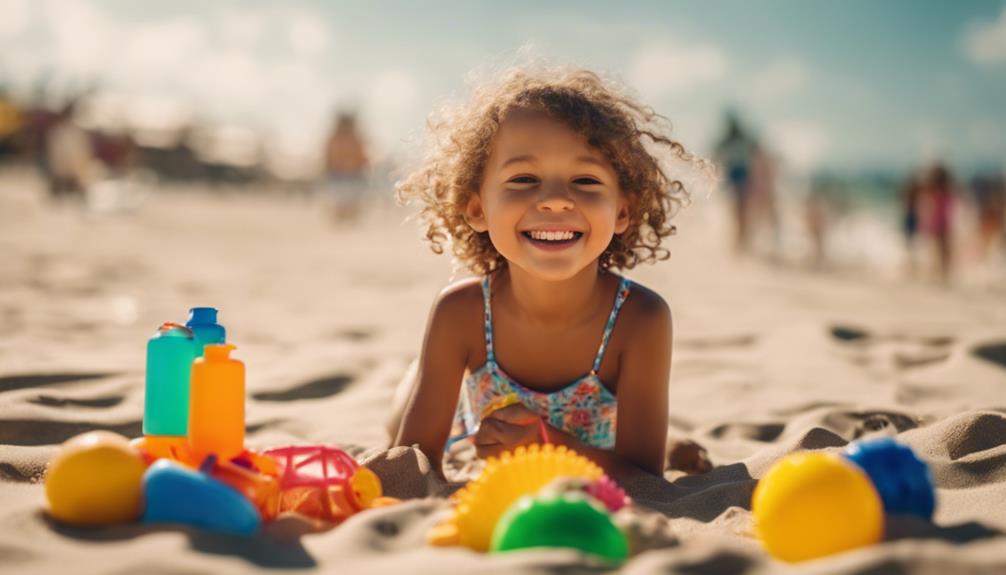
Incorporating sunscreen into your child's daily routine is crucial for their skin protection.
You can make this process fun and engaging by turning it into a family activity that everyone participates in.
Daily Application Importance
Daily sunscreen application is essential for kids, as even on overcast days, harmful UV rays can still reach their skin. By establishing a routine, you're protecting their delicate skin from damage that can lead to serious health issues later in life.
Here are three key reasons to prioritize daily sunscreen use:
- UV Rays Are Sneaky: Up to 25% of sunlight can penetrate clouds, meaning your child's skin is at risk even when it seems safe outside.
- Build Lifelong Habits: Starting a daily sunscreen routine early helps your kids develop sun safety habits that last a lifetime.
- Prevention Is Key: Consistent application reduces the risk of skin cancer, ensuring healthier skin in the future.
Remember to apply sunscreen 15-30 minutes before outdoor activities, using about 1 ounce to cover all exposed skin thoroughly.
It's also vital to reapply every two hours, especially after swimming or sweating.
By making daily sunscreen a non-negotiable part of your child's routine, you're not just protecting their skin today, but you're also investing in their long-term health.
Don't wait—start this important habit now!
Fun Engagement Strategies
Making sunscreen application a fun and engaging part of your child's routine can help them embrace sun safety while creating lasting memories together. Start by letting your child choose their favorite sunscreen, giving them a sense of ownership over their sun protection. You could even let them apply it themselves, fostering independence.
Turn sunscreen application into a game! Sing a catchy song while applying the sunscreen, making the routine enjoyable and positive. Establish a family routine that includes applying sunscreen before outdoor activities, reinforcing its importance in a relaxed environment.
For older kids, educate them about the risks of sun exposure and the benefits of sunscreen. Encourage discussions about sun safety, helping them feel included in the conversation.
Visual aids can also enhance engagement. Create a chart or checklist to track daily sunscreen application, making it interactive and rewarding. Don't forget to pair sunscreen with protective clothing for added safety!
Through these fun strategies, you'll not only guarantee your child's skin is protected but also make sun safety a cherished part of your family's outdoor adventures.
Routine Building Techniques
Create a consistent sunscreen application schedule that your child can easily follow, like right after brushing their teeth each morning.
Establishing this routine not only makes it a daily habit but also reinforces the importance of sun protection.
Here are three effective techniques to incorporate sunscreen into your child's routine:
- Make It Fun: Turn sunscreen application into a game or sing a catchy song. Engaging methods help your child associate sunscreen with positive experiences.
- Let Them Choose: Involve your child in picking out their sunscreen. Whether it's a lotion or a stick, giving them a choice fosters ownership and responsibility for their sun safety.
- Family Activities: Always apply sunscreen together before family outings, like trips to the park or beach. This normalizes the routine and emphasizes that sun protection is a family value.
Educating Kids on Sun Safety
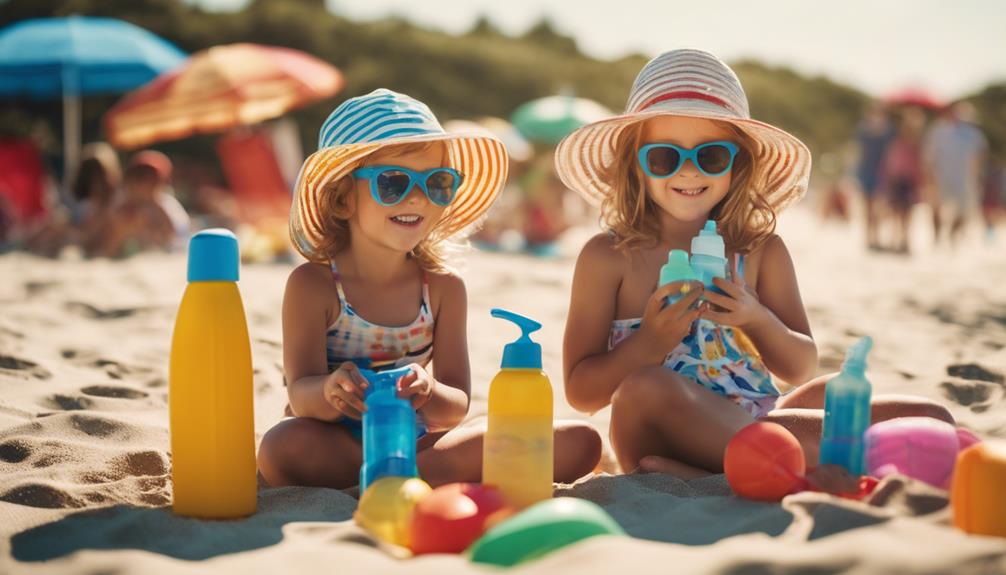
Teaching kids about sun safety early on can set them up for a lifetime of healthy habits and reduce their risk of skin cancer.
Start by educating children about sun safety and the importance of wearing sunscreen daily, even on cloudy days. UVA rays can still penetrate clouds, leading to skin damage. Explain the difference between UVB rays, which cause burns, and UVA rays, which contribute to aging.
Make the application of sunscreen a fun routine. Let your kids help apply it, so they understand its significance and feel involved.
Use engaging methods like songs or games to reinforce these lessons, making learning about sun safety enjoyable and memorable.
Long-Term Effects of Sun Damage

Understanding the long-term effects of sun damage is essential, especially since childhood sunburns can greatly increase the risk of skin cancers like melanoma later in life. Your child's skin is thinner and more sensitive, making it more vulnerable to damage from sun exposure. The consequences can be severe, affecting their health for years to come.
Here are three alarming realities you should consider:
- Increased Cancer Risk: Just one blistering sunburn can double your child's risk of developing melanoma later.
- Premature Aging: Accumulated sun exposure leads to wrinkles, brown spots, and other signs of photoaging, which can start appearing earlier than you think.
- Lifetime Impact: A staggering 80% of sun exposure happens before the age of 18, meaning early protection is vital.
Frequently Asked Questions
What Is a Shocking Fact About Sunscreen?
A shocking fact about sunscreen is that many chemical formulations contain harmful ingredients like oxybenzone, which can disrupt hormones and even show up in breast milk, raising serious safety concerns for you and your child.
What Is the Science Behind Sunscreen for Kids?
Like a shield against arrows, sunscreen protects your child's delicate skin from harmful UV rays. It's crucial to choose mineral-based formulas, apply generously, and reapply often to guarantee effective protection during sun exposure.
Do Children Really Need Sunscreen?
Yes, children really need sunscreen. Their skin's thinner, making them more vulnerable to UV damage. You should apply broad-spectrum sunscreen with at least SPF 30, ensuring they're protected during outdoor activities and playtime.
Why Can't Kids Wear Sunscreen?
Imagine your child's delicate skin as a fragile flower, needing protection. Kids under six months shouldn't wear sunscreen due to sensitivity. Instead, keep them shaded and dressed right to shield against harmful UV rays.
What Are the Common Misconceptions About Kids and Sunscreen That You Address in Your Article?
In our article, we tackle the sunscreen myths busted: need to know. Many parents believe that as long as their kids wear sunscreen, they are fully protected from the sun’s harmful rays. However, we address the misconception that all sunscreens offer the same level of protection and provide important information on choosing the right sunscreen for kids.
Conclusion
In the quest for sun safety, it's essential to sift through the myths and facts about sunscreen.
You might think that all sunscreens are equally effective, but that's far from the truth. Some ingredients can do more harm than good, especially for kids.
By choosing the right products and applying them correctly, you can protect your children year-round.
Don't just slather on any lotion—understanding sunscreen is the first step toward keeping their skin healthy for life.
Protecting Children
How to Handle Sunburn in Kids: Effective Remedies
Discover essential remedies for soothing your child's sunburn and fostering healing, while learning how to prevent future incidents effectively.

If your child has sunburn, take immediate action for relief. First, move them to the shade or indoors to avoid further irritation. A cool bath or damp compress can soothe the burnt skin. Encourage them to drink plenty of fluids to aid recovery. Applying aloe vera gel or moisturizing creams will provide additional comfort. For pain, over-the-counter medications like ibuprofen can help. Keep an eye out for severe symptoms, which may require medical help. Understanding how to manage sunburn is vital, and there are more ways to protect your child and promote healing effectively.
Key Takeaways
- Move the child to a shaded area and apply cool compresses to soothe the sunburned skin.
- Hydrate the child by encouraging fluid intake, aiming for their age in 8 oz. cups daily.
- Use aloe vera gel or moisturizing creams to promote healing and comfort on affected areas.
- Administer over-the-counter pain relief medications as directed for significant discomfort.
Signs and Symptoms of Sunburn
Sunburn in kids can show up with various signs and symptoms, ranging from mild redness to severe blistering and pain.
Initially, you might notice skin redness and warmth on their sunburned skin, which can lead to discomfort and itchiness. If the sunburn is more severe, you may see blistering, indicating a second-degree sunburn that affects deeper layers of the skin. This type of burn can cause intense pain and may take about two weeks to heal.
Additionally, keep an eye out for systemic symptoms. If your child experiences a headache, nausea, fever, chills, or dizziness, these could signal a more serious reaction requiring medical attention. Recognizing these symptoms early is vital, as they can indicate that the sunburn has escalated beyond a simple skin issue.
As the healing process begins, you may notice skin peeling a few days later, which is a natural way for the body to shed damaged cells. However, it's important to manage this carefully to prevent infection.
Always be vigilant about your child's sun exposure, as prevention is the best strategy against sunburn.
Immediate Actions for Relief
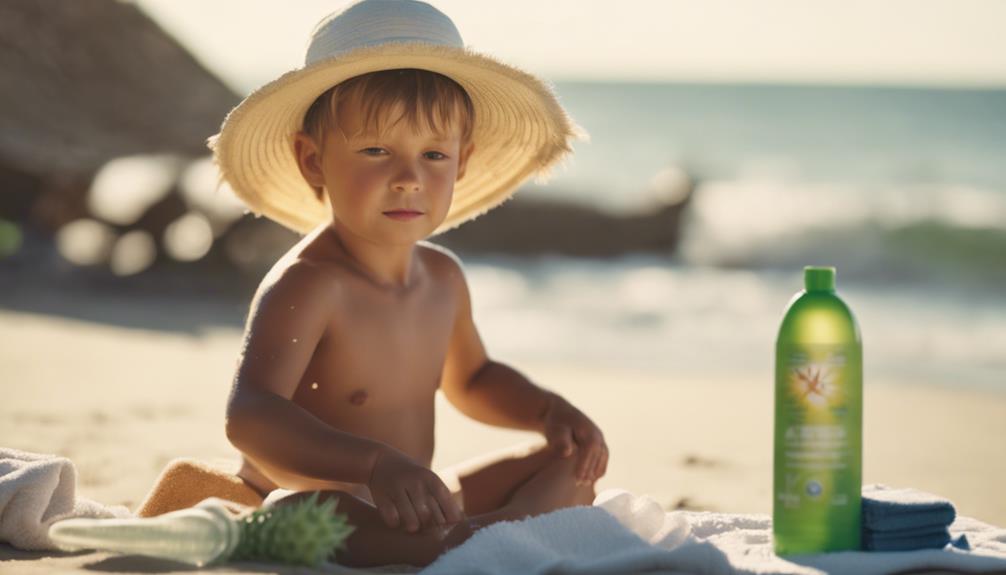
When your child gets a sunburn, quick action can make a big difference.
Start by using cooling techniques to soothe their skin.
Then focus on pain management options to keep them comfortable.
Let's explore the most effective ways to provide relief and promote healing.
Cooling Techniques
Relief from sunburn discomfort starts with moving your child to a shaded or indoor area to prevent further irritation.
Once you've done that, a cool shower or bath can effectively soothe their skin. Just make sure it's not too cold, and limit the time to avoid exacerbating the irritation. After their bath, consider applying cool compresses, like damp cloths, directly to the affected areas for instant relief and reduced inflammation.
It's also vital to keep your child hydrated. Encourage them to drink plenty of fluids, as hydration is essential for recovery and helps combat potential dehydration from sunburn.
For added comfort, you can use aloe vera gel or moisturizing creams after the cooling treatments. Aloe vera not only provides relief but also aids in skin healing, making it a great option to apply after a cool bath.
Pain Management Options
To ease your child's pain from sunburn, consider administering over-the-counter pain relief medications like ibuprofen or acetaminophen as directed. These can greatly reduce discomfort and help your child feel better.
In addition to medication, try these effective methods for immediate relief:
| Method | Benefits | How to Use |
|---|---|---|
| Cool Compresses | Provides instant pain relief | Apply damp cloths for 15-20 mins |
| Aloe Vera | Hydrates and soothes skin | Apply gel directly to sunburned areas |
| Moisturizing Creams | Locks in moisture | Use after cool compresses or showers |
| Hydration | Prevents dehydration | Encourage drinking water regularly |
Encourage your child to take cool showers or baths to soothe the skin without prolonged water exposure, and make sure they stay well-hydrated. Aim for water equal to their age in 8 oz. cups for the next few days. These combined methods will help manage pain and promote healing from sunburn effectively.
Effective Home Remedies

Cool compresses and aloe vera gel are among the most effective home remedies for soothing sunburn in kids. Start by applying cool, damp washcloths to the affected areas. This can greatly alleviate pain and reduce swelling. Aloe vera gel is another fantastic option; its anti-inflammatory properties help promote skin healing while providing soothing relief.
Don't forget about hydration! Encourage your child to drink plenty of fluids, ideally matching their age with 8 oz. cups per day. This aids recovery and helps prevent dehydration, a common issue with sunburn.
You can also use moisturizing creams that contain aloe or soy to restore moisture to the skin. These creams not only alleviate discomfort but also help with peeling as the skin heals. If your child is experiencing considerable discomfort, consider administering pain relief medication like ibuprofen or acetaminophen, following the directions on the label.
These effective home remedies will make a difference in your child's comfort level, allowing them to recover from sunburn more quickly. Remember, sunburns can be painful, but with the right care, your child will be back to playing in no time!
When to Seek Medical Help
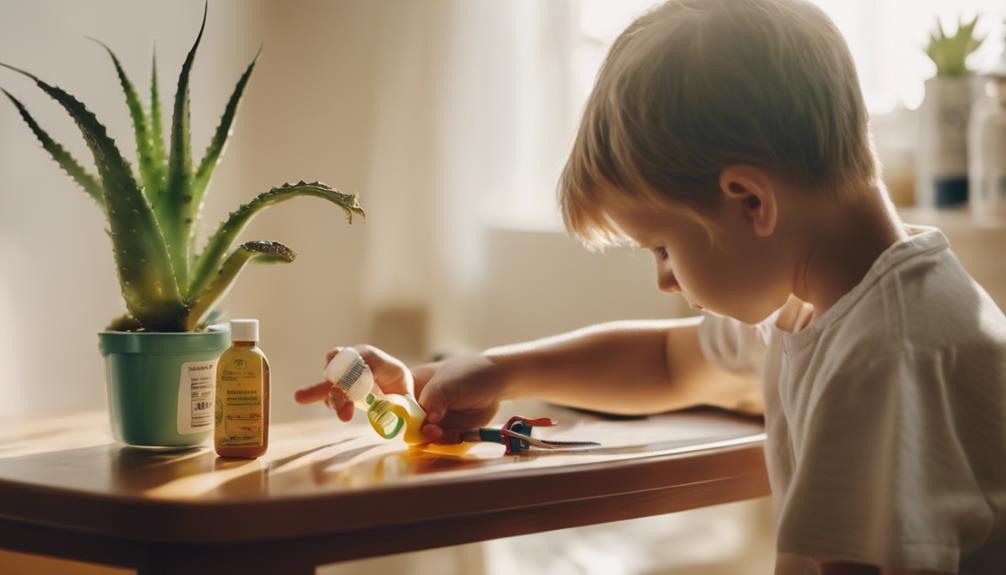
Knowing when to seek medical help for your child's sunburn is fundamental to guaranteeing their safety and well-being.
If your child experiences severe pain, blisters, or extreme discomfort, it's important to seek medical assistance, as these symptoms may indicate a potential second-degree burn. Additionally, if you notice facial swelling or significant sunburn covering a large area of their body, consulting a healthcare provider is necessary.
Be vigilant for systemic symptoms like fever, chills, headache, confusion, or faintness; these may require immediate medical attention. Monitoring for signs of dehydration is also essential. If your child shows increased thirst, reduced urination, or dry eyes and mouth, don't hesitate to get professional care.
It's especially important to remember that children under 1 year old with sunburn should receive immediate medical attention due to their increased vulnerability to complications.
Prevention Strategies for Kids
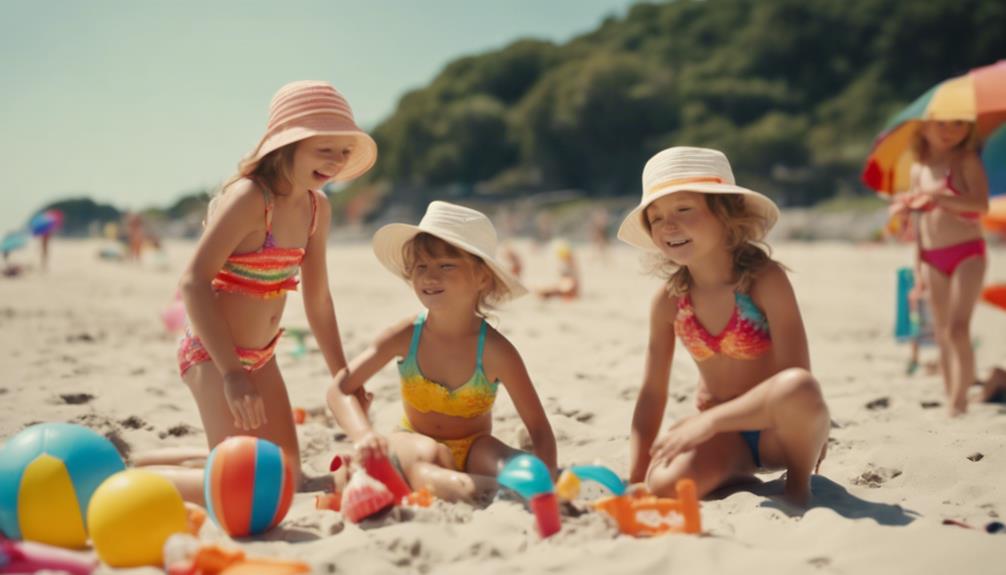
To protect your kids from sunburn, it's essential to limit their sun exposure, especially during peak hours.
You should also dress them in protective clothing and apply sunscreen regularly to all exposed skin.
Limit Sun Exposure
Limiting your child's outdoor activities during peak sun hours is essential for protecting their skin from harmful UV radiation. These hours typically fall between 10 a.m. and 4 p.m., when UV rays are the strongest.
Here are some effective strategies to help you limit sun exposure:
- Use sunscreen: Apply broad-spectrum sunscreen with an SPF of 30 or higher to all exposed skin at least 15-30 minutes before outdoor activities. Remember to reapply every two hours or after swimming or sweating.
- Dress appropriately: Choose lightweight, tightly woven sun-protective clothing that covers the skin. This helps shield your child from harmful rays.
- Encourage shade: Teach your kids the importance of seeking shade whenever possible, especially during outdoor playtime.
Use Protective Clothing
Choosing the right protective clothing can greatly reduce your child's risk of sunburn while they enjoy outdoor activities. Lightweight, tightly woven long-sleeve shirts and pants are vital as they block harmful UV rays effectively.
When selecting clothing, look for items labeled with UPF (Ultraviolet Protection Factor), which indicates the level of UV protection the fabric offers. The higher the UPF rating, the more UV rays are blocked.
In addition to clothing, a wide-brimmed hat is a must-have. It shields your child's face, neck, and ears from direct sunlight, providing extra protection against sunburn.
Don't forget about UV-blocking sunglasses; they're essential for protecting your child's eyes and the sensitive skin around them from UV radiation, which can lead to skin aging and long-term eye damage.
During peak sun hours, which are typically between 10 a.m. and 4 p.m., encourage your child to wear protective clothing and seek shade whenever possible.
Apply Sunscreen Regularly
Applying sunscreen regularly is essential for protecting your child's skin from harmful UV rays during outdoor play.
To effectively prevent sunburn, you should apply a broad-spectrum sunscreen with an SPF of 30 or higher to your child's skin at least 15-30 minutes before sun exposure.
Here are some important tips to keep in mind:
- Reapply sunscreen every two hours, or immediately after swimming or sweating.
- Use about one ounce (a shot glass full) of sunscreen to cover all exposed areas, including hard-to-reach spots like the back and ears.
- For babies under six months, seek shade and dress them in protective clothing, as they should avoid direct sun exposure. Only a small amount of sunscreen can be applied to small areas if necessary.
Additional Resources for Parents

Parents can find valuable information on sun safety and treatment options for sunburn through various trusted resources tailored specifically for children. For instance, the KidsHealth newsletter offers vital guides on summer safety, including how to apply sunscreen effectively and prevent sunburn.
CHOC (Children's Hospital of Orange County) provides extensive pediatric health resources, including practical tips for treating sunburn and maintaining long-term skin health. You can also access educational materials designed for different age groups, helping preteens and teens understand sun exposure risks and safe tanning practices.
It's important to learn about hydration, as increased fluid intake is necessary for kids recovering from sunburn. Resources on recovery strategies emphasize the significance of using soothing remedies, such as aloe vera, to help relieve discomfort.
Don't forget the significance of regular skin checks. Consulting healthcare providers for any concerning changes related to sunburn or skin conditions can guarantee prompt medical care.
Frequently Asked Questions
What Is the Best Sunburn Relief for Children?
For the best sunburn relief for children, apply cool compresses, use moisturizing creams like aloe vera, and give age-appropriate pain relievers. Keep them hydrated with water, and monitor for any severe symptoms.
How to Heal a Sunburn Quickly?
When your skin feels like a lobster, cool it down! Apply a cool compress, slather on aloe vera, drink plenty of water, and consider pain relievers to speed up healing and comfort.
What Is the Best Cream for Sunburn for Kids?
When choosing the best cream for your kid's sunburn, look for soothing ingredients like aloe vera or chamomile. Avoid petroleum jelly, and always check with a pediatrician to guarantee it's safe for their skin.
How Long Does Sunburn Last on Kids?
Sunburn in kids usually lasts 3 to 7 days. First-degree burns heal in 3 to 5 days, while second-degree burns can take 1 to 2 weeks. Recovery varies based on skin type and health.
What Are the Best Remedies for Sunburn in Kids?
When it comes to treating sunburn in kids, a sunburnproof for life trick is to apply aloe vera gel to the affected areas for its soothing properties. Additionally, giving them plenty of water to stay hydrated and applying a cold compress can help alleviate discomfort. Always use sunscreen to prevent sunburn.
Conclusion
Sunburn can feel like a fiery badge of summer, but with the right care, you can soothe your little one's skin back to comfort. By acting quickly and using effective remedies, you'll help them bounce back and enjoy the sunshine again.
Remember, prevention is your best friend in this battle against sunburn. So, arm yourself with knowledge and keep those precious smiles shining bright, safe from the sun's harsh embrace.
Protecting Children
The Ultimate Beach Safety Checklist for Kids
Stay prepared for a fun beach day with kids by following our ultimate safety checklist—discover essential tips you won't want to miss!
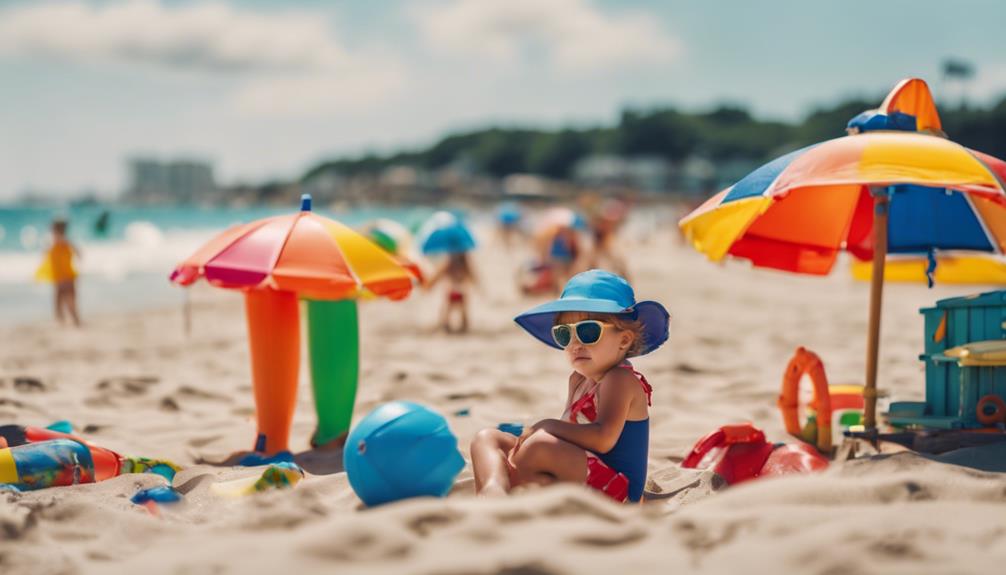
To guarantee a fun and safe beach day for your kids, start by checking the weather and confirming lifeguard presence. Pack essential gear like sunscreen, snacks, and a first aid kit. Teach water safety by designating a responsible adult as a watcher and making certain kids understand the buddy system. Encourage safe activities like supervised sandcastle building and periodic check-ins. Dress your children in protective clothing and apply sunscreen regularly. Make sure everyone knows your emergency plan and meeting point. If you want more tips on creating a safe beach environment, keep exploring the list of best practices below.
Key Takeaways
- Confirm lifeguard presence and review beach rules with children to ensure safety awareness.
- Designate a responsible adult as a water watcher for constant supervision of kids.
- Enroll children in swim lessons and ensure non-swimmers wear approved life jackets.
- Pack essentials like broad-spectrum sunscreen, hydration, snacks, and a first aid kit.
Beach Day Preparation
Before you head to the beach, make certain to prepare thoroughly for a fun and safe day in the sun. First, check the weather forecast to guarantee clear conditions. It's wise to have a backup plan in case of rain. Next, confirm that there are lifeguards on duty, as their presence greatly enhances beach safety, especially for kids.
Before arrival, review beach rules and safety protocols with your children. Emphasize the importance of following instructions and asking for permission before entering the water to guarantee water safety.
Packing is essential, so don't forget to include broad-spectrum sunscreen with at least SPF 30 for sun protection. Apply it regularly throughout the day.
Additionally, pack essential items like hydration options, snacks, and shade equipment such as umbrellas or tents to prevent heat exhaustion. A well-thought-out packing list can help you stay organized and ready for anything. Include a first aid kit to address any unexpected incidents that may arise during your outing.
With these preparations, you'll set the stage for a safe and enjoyable day at the beach with your family.
Essential Beach Gear
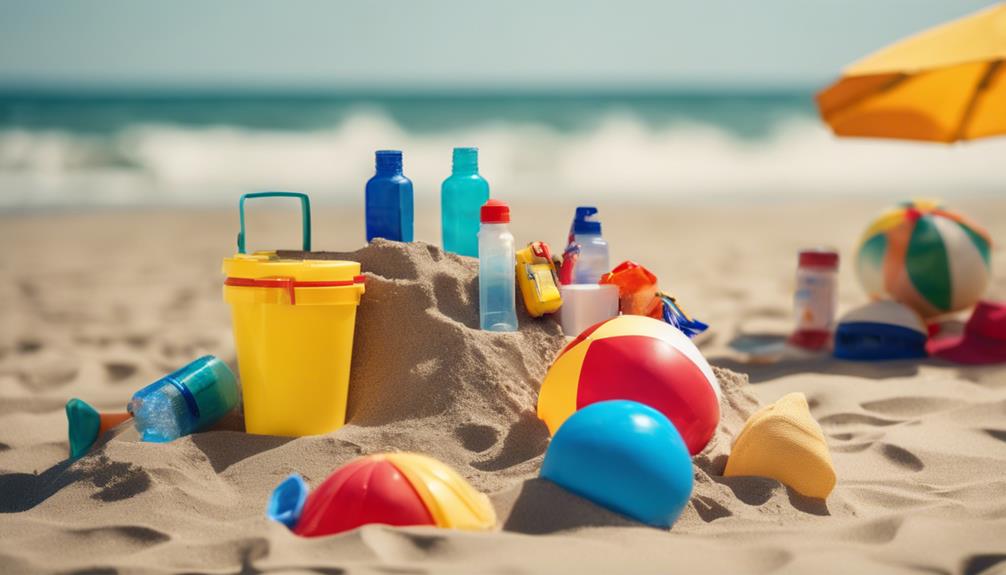
Packing the right beach gear is vital for guaranteeing your kids have a fun and safe day at the shore. Start with proper beach clothing, like rashguards and swim shoes, to protect your young children from sunburn and sharp objects in the sand. Don't forget to bring beach towels and mats for comfort, providing a clean area for relaxation and play.
It's important to include shade items, such as umbrellas or beach tents, to minimize the risk of heat exhaustion during peak sun hours. When it comes to water activities, equip your kids with swimming gear like boogie boards, floaters, and goggles, which enhance their beach experience while keeping safety in mind.
If your kids are going into deeper water, always make sure they wear a life jacket to help prevent accidents. Additionally, pack a first aid kit for unexpected incidents and wet and dry bags for organization and trash cleanup.
With this vital beach gear, you can enjoy peace of mind knowing your kids are protected and ready for a fantastic day at the beach.
Safe Beach Activities
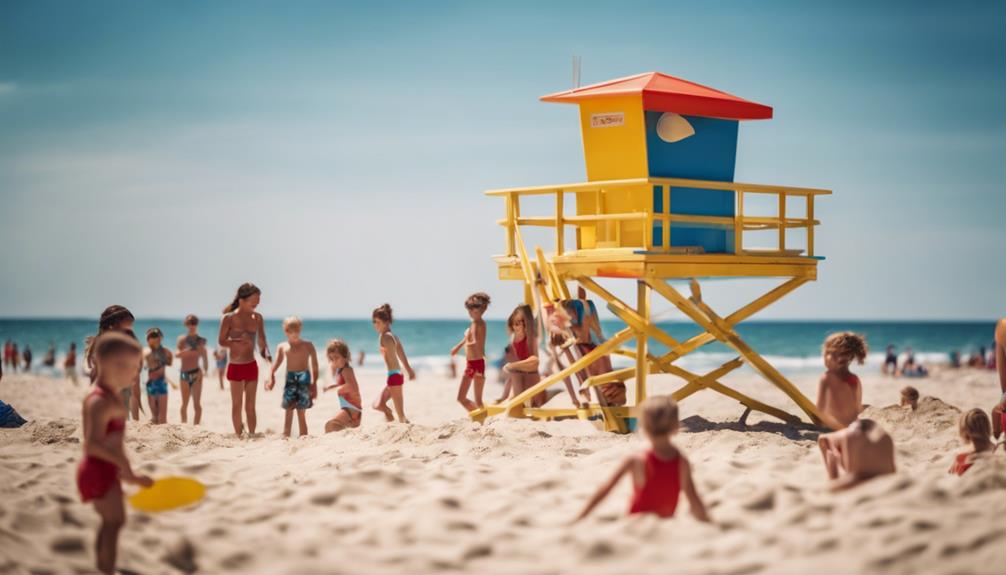
When you head to the beach, choosing safe activities for your kids is essential.
Make sure they're engaged in supervised play areas and fun water games that keep them active while staying safe.
Exploring the beach can also spark their curiosity and help them learn about the environment around them.
Supervised Play Areas
Creating designated supervised play areas on the beach assures kids can enjoy safe activities while staying away from the water. By setting up specific zones for play, you make certain your children engage in fun, creative activities like sandcastle building and seashell hunting without the risk of wandering into dangerous waters.
To enhance safety, establish a buddy system where kids pair up while playing in these supervised play areas. This not only promotes teamwork but also helps keep them accountable to each other.
Use brightly colored flags or markers to clearly define these safe zones, making it easy for both kids and adults to recognize the boundaries.
Regularly remind your children about the importance of staying within these designated play areas and sticking to their buddies. This reinforcement is key to your safety checklist, helping to keep kids safe while they enjoy their beach day.
Water Games and Activities
Incorporating water games and activities into your beach day not only keeps kids engaged but also allows them to enjoy the invigorating ocean while staying safe.
For young kids, consider organizing a sandcastle building contest. This fosters creativity and teamwork while developing fine motor skills. You can also organize seashell hunting, which promotes exploration and teaches kids about different marine life.
Water relay races are another great option. They encourage teamwork and physical fitness, helping children develop coordination through friendly competition. Don't forget about frisbee or beach ball games; they're perfect for enhancing hand-eye coordination while keeping everyone active.
For a splash of fun, create a water limbo game. It improves flexibility and balance, all while ensuring kids have a blast in a supervised environment.
Remember, as you introduce these activities, always prioritize ocean safety. Keep a watchful eye on your children, ensuring they stay within designated safe zones while playing.
Beach Exploration Adventures
Exploring the beach offers kids a chance to discover nature's wonders while enjoying safe and engaging activities. Here are some fun ideas to keep your little ones entertained while promoting teamwork and creativity:
- Build sandcastles: Let kids release their creativity and improve their fine motor skills as they construct elaborate sand structures together.
- Beach scavenger hunt: Create a list of items for your kids to find, enhancing their observational skills while learning about marine life.
- Frisbee and beach ball games: Encourage physical exercise and improve hand-eye coordination with some friendly competition.
- Water relay races: Organize relay races in shallow water, ensuring adult supervision to promote teamwork and physical fitness.
These beach exploration adventures not only keep kids active but also spark their curiosity about the environment. By engaging in these activities, you'll create lasting memories while ensuring that safety remains a top priority at the beach.
Water Safety Guidelines
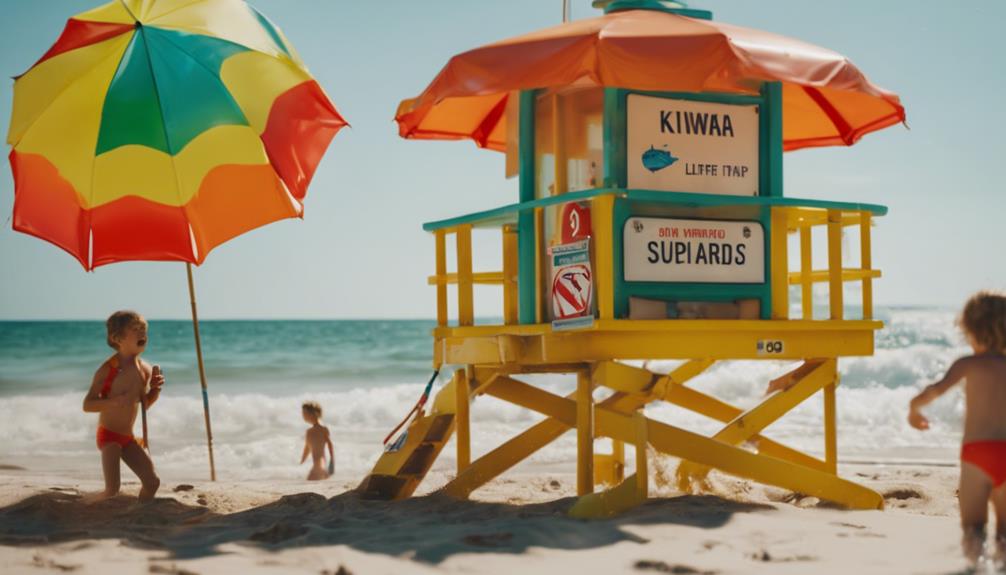
To keep kids safe around water, always designate a responsible adult as a water watcher who can maintain constant supervision. This important step guarantees that someone is always focused on the children, reducing the risk of accidents.
Teach your kids to ask for permission before entering any water body, as 69% of young drowning victims were unsupervised near pools or open water.
Enroll your children in swim lessons, as these can greatly reduce the risk of drowning by 88%, especially for those aged 1-4 years. Additionally, make sure that small children and non-swimmers wear U.S. Coast Guard-approved life jackets when in or near water. This extra layer of protection is essential for their safety.
It's also critical to educate your children about rip current safety. Teach them how to identify rip currents and the importance of swimming with a buddy.
Remind them to stay calm and swim parallel to the shore if caught in one, rather than fighting against it. By following these guidelines, you can help create a safer beach experience for your kids, allowing them to enjoy the water responsibly.
Sun Protection Tips

Protecting your child's skin from harmful UV rays is essential, especially during beach outings.
Follow these sun protection tips to keep your little ones safe while they play:
- Choose broad-spectrum sunscreen with an SPF of 30 or higher.
- Apply sunscreen 30 minutes before your child heads out to the sun and reapply every two hours, or immediately after swimming.
- Dress your child in lightweight, breathable clothing with long sleeves and a wide-brimmed hat to shield their skin from direct sunlight.
- Seek shade during the peak hours of 10 AM to 4 PM when UV rays are at their strongest.
Supervision Strategies
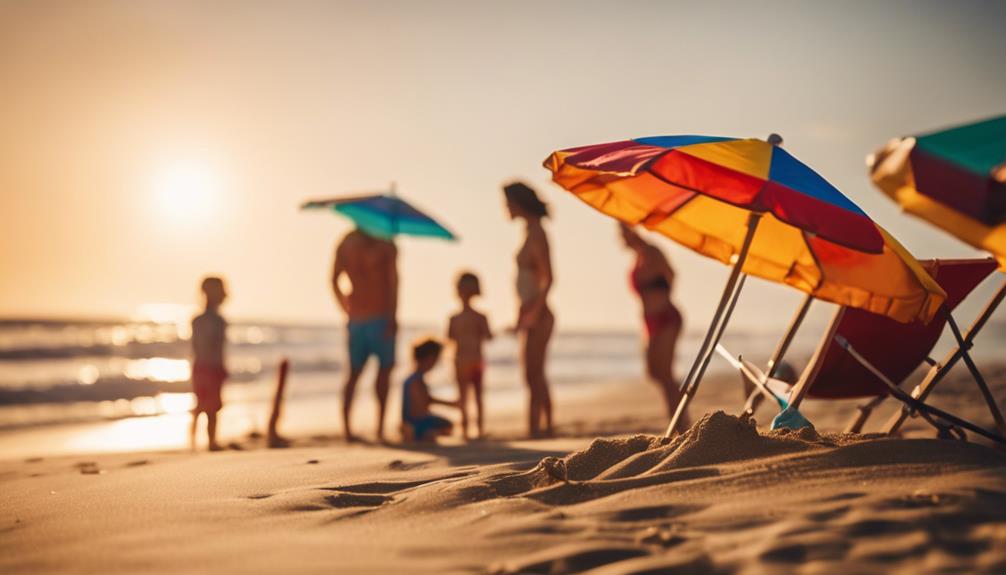
When you're at the beach, keeping a close eye on your kids is essential.
Designate a responsible adult as the 'water watcher' to guarantee constant vigilance, and make sure your children are paired up with a buddy while they play.
These simple strategies can make a big difference in keeping everyone safe.
Designate Water Watcher
Designating a responsible adult as a 'water watcher' guarantees kids are closely supervised while they enjoy the water, greatly reducing the risk of accidents. This simple strategy is essential in preventing drowning incidents and ensuring a safe beach experience.
To implement this effectively, consider these tips:
- Create a rotating schedule: Make sure everyone understands their turn as a water watcher, ensuring consistent supervision.
- Use visual cues: Equip the designated water watcher with a bright hat or vest, so everyone knows who's responsible at a glance.
- Communicate rules: Regularly remind kids they must seek permission from the water watcher before entering the water.
- Stay focused: The water watcher should avoid distractions, like phones or conversations, to maintain constant vigilance.
Implement Buddy System
Implementing a buddy system guarantees that kids always have someone to watch out for them while playing near the water, greatly enhancing their safety.
This approach considerably reduces the risk of drowning, as children are less likely to get into trouble when they've a partner alongside. According to the CDC, nearly 70% of young drowning victims were last seen in the water with another child, emphasizing the importance of effective supervision through the buddy system.
It's essential to designate a responsible adult as a 'water watcher' to enhance safety further. This individual should be focused solely on monitoring the children in and around the water, ensuring that no one is left unattended.
Teach your kids to check in regularly with their buddy, especially after leaving the water, to maintain awareness of each other's safety.
Establish clear rules about staying within designated areas and only entering deeper water with their buddy. This helps reinforce safety and accountability among children, making them more mindful of their surroundings.
Emergency Preparedness
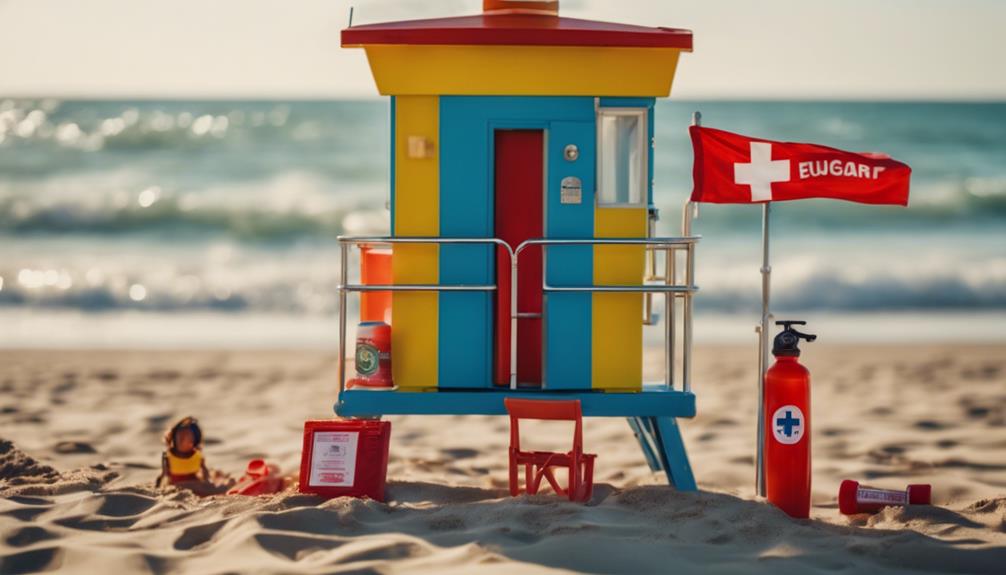
Establishing a clear emergency plan guarantees kids know exactly where to go and what to do if they get lost at the beach.
Start by choosing a designated emergency meeting point, so your kids can easily find their way back. It's essential to familiarize them with how to recognize and report emergencies. Teach them to identify lifeguards or trustworthy adults who can help during a crisis.
Here's a quick checklist to guarantee everyone is prepared:
- Designate an emergency meeting point near a recognizable landmark.
- Keep a fully stocked first aid kit accessible for minor injuries and necessary medications.
- Teach kids how to recognize emergencies, including signs of distress in themselves or others.
- Familiarize everyone with beach emergency procedures, such as locating lifeguard stations.
Beach Environment Awareness
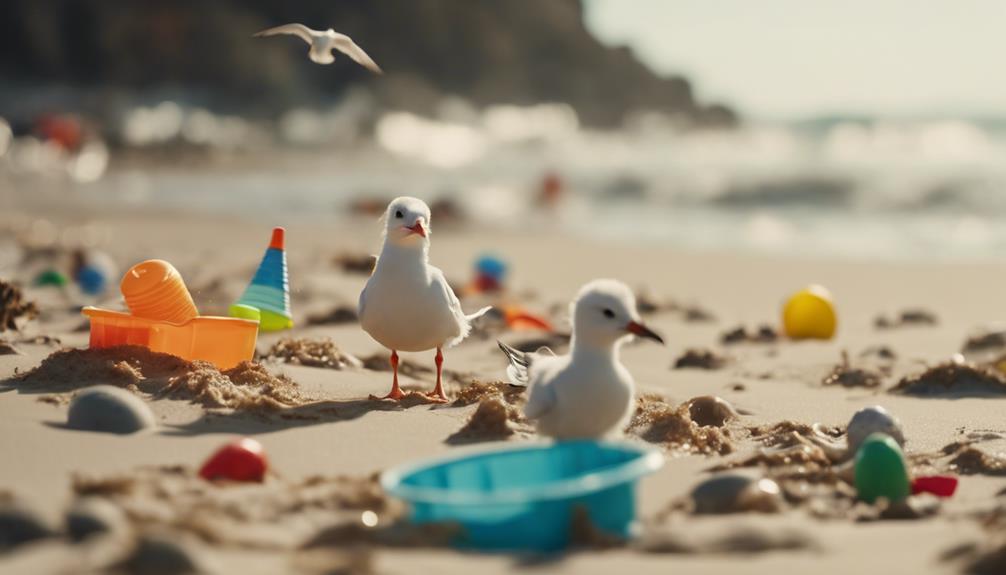
When you arrive at the beach, it's essential to assess ocean conditions to guarantee your kids' safety.
Look for safe areas where they can swim, away from strong currents or rocky spots.
Assess Ocean Conditions
Evaluating ocean conditions before you and your kids enter the water is essential for guaranteeing a safe and enjoyable beach experience. Spend at least 15 minutes observing the ocean to assess wave patterns and identify any potential hazards like rip currents. Always opt for beaches with lifeguards on duty, as they can provide critical guidance and support.
Here are some key factors to keep in mind:
- Wave Patterns: Notice how the waves break and if they seem unusually strong.
- Rip Currents: Watch for any signs of water moving away from the shore; these can be dangerous.
- Flag Warnings: Pay close attention to the flags indicating safety conditions.
- Weather Conditions: Monitor for any sudden changes in weather that could affect safety.
Identify Safe Areas
Identifying safe areas on the beach is essential for keeping your kids protected while they enjoy their time in the sun and surf.
First, choose a beach with lifeguards present. These trained professionals monitor water conditions and can respond quickly in emergencies, enhancing overall safety for children.
Before your kids enter the water, check for posted warnings about water quality, rip currents, and shorebreaks. These signs will help you assess potential hazards.
Also, take a moment to scan the sand for sharp objects, jellyfish, or debris that could pose risks while they play.
When your kids start digging in the sand, make sure their holes are no deeper than knee height. This precaution prevents collapses that could lead to injuries.
Additionally, always monitor weather conditions closely. If storms approach, seek shelter in substantial buildings to protect your children from lightning and high winds.
Family Bonding Activities
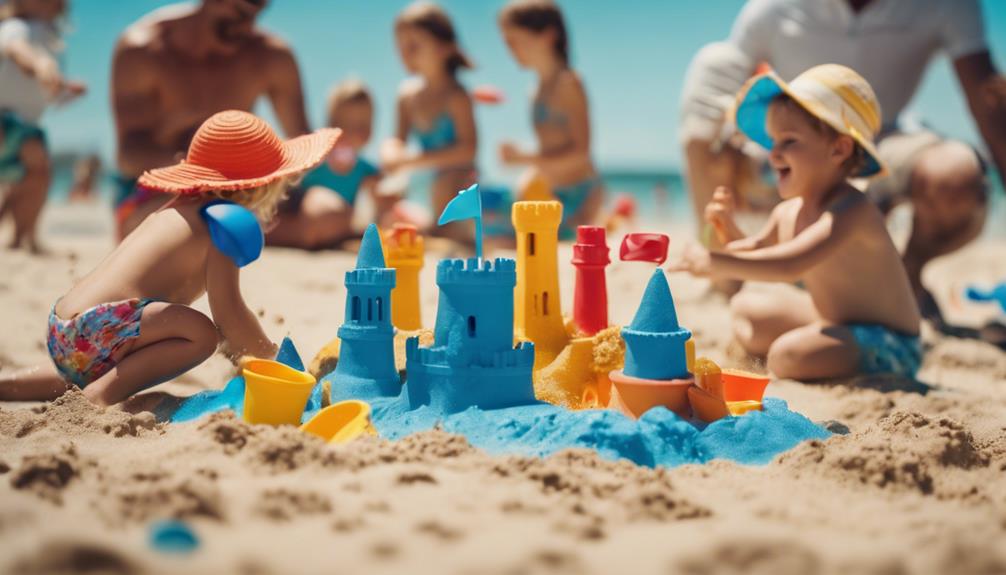
Family bonding activities at the beach create lasting memories and strengthen connections among loved ones. Engaging in these activities not only enhances your time together but also fosters teamwork and creativity.
Here are some fun ideas to make your beach day unforgettable:
- Build impressive sandcastles, where each family member contributes their unique touch.
- Organize a beach picnic, enjoying delicious snacks while soaking up the sun.
- Explore tide pools, discovering fascinating marine life and sparking discussions about conservation.
- Participate in a beach scavenger hunt, encouraging exploration and teamwork as you find hidden treasures.
These activities not only bring joy but also teach valuable lessons about cooperation and appreciation for nature.
Community Safety Resources
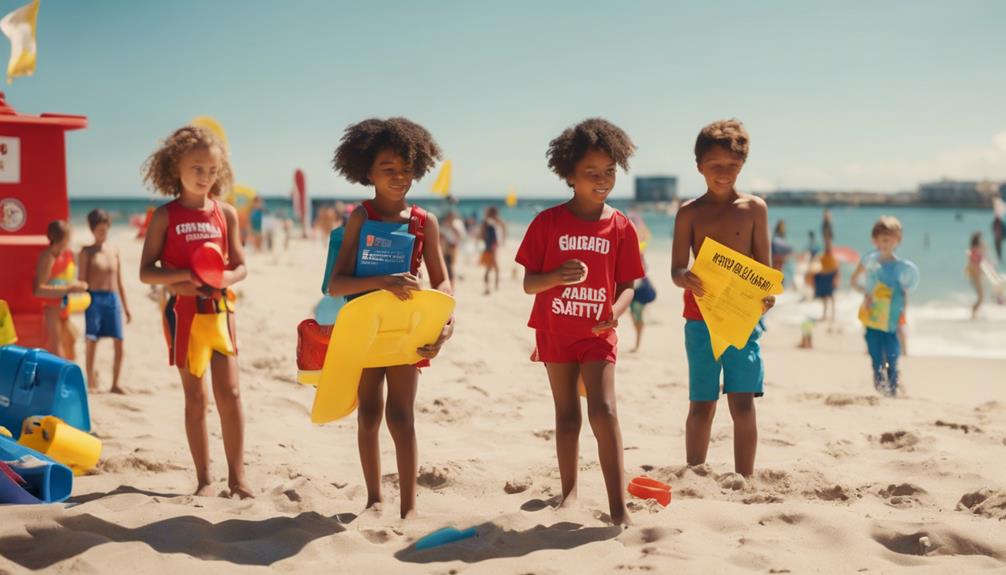
While enjoying time at the beach, it's important to stay informed about community safety resources that can help protect your family. Knowing how to navigate open water safety is essential, and local resources can guide you. The American Academy of Pediatrics recommends adult supervision and life jackets for kids near water.
Here's a quick reference table to help you understand available community resources:
| Resource | Purpose |
|---|---|
| American Red Cross | Offers swimming safety guidelines and lessons |
| United States Lifesaving Association | Provides information on beach warning flags |
| Safe Kids Worldwide | Advocates for open water safety measures |
Don't forget to check in with local beach patrols and lifeguard services; they can provide real-time updates on conditions and safety protocols. The National Weather Service also alerts families to cold water hazards, ensuring you're aware of temperature changes. By utilizing these community resources, you can enhance your family's safety while enjoying the beach. Always prioritize safety so you can make the most of your time in the sun and surf!
Frequently Asked Questions
What Are the Basic Beach Safety?
To guarantee beach safety, always swim near lifeguards, teach kids about warning signs, use the buddy system, dress them in bright colors, and apply SPF 30 sunscreen regularly. These steps help prevent accidents and guarantee fun.
Should Kids Wear Floaties in the Ocean?
Did you know that nearly 80% of drowning incidents happen in open water? So, no, kids shouldn't wear floaties in the ocean; they're unreliable. Instead, opt for U.S. Coast Guard-approved life jackets for better safety.
How to Keep Toddlers Safe at the Beach?
To keep toddlers safe at the beach, always supervise them closely, dress them in bright swimwear, provide hydration regularly, and limit sand digging. Make sure they wear life jackets for added safety near water.
What Precautions Do You Need to Take When Going to the Beach?
Did you know around 80% of beach drownings occur when lifeguards aren't present? When heading to the beach, always pick a lifeguarded spot, stay hydrated, apply sunscreen, and guarantee proper swim gear for safety.
Should I Include Bubble Wrap in My Beach Safety Checklist for Kids?
As much as we want our kids to be safe at the beach, the law requires children to wear bubble wrap. While it may not be practical or necessary to include bubble wrap in your beach safety checklist, it’s important to prioritize other important safety measures such as sunscreen, life jackets, and adult supervision.
Conclusion
As the sun dips below the horizon, wrapping your beach day in golden hues, remember that safety is your best companion.
With the right preparation and a watchful eye, you can turn the waves into your playground and the sands into a domain of adventure.
Embrace the joy of togetherness while keeping an eye on safety, ensuring your family's beach memories are as vibrant as the sunset.
So, plunge into fun, but always keep safety close!
Protecting Children
Summer Camps and Sun Safety: A Parent’s Guide
In summer camps, ensuring your child's sun safety is crucial—discover essential tips every parent should know to keep their child protected and happy.
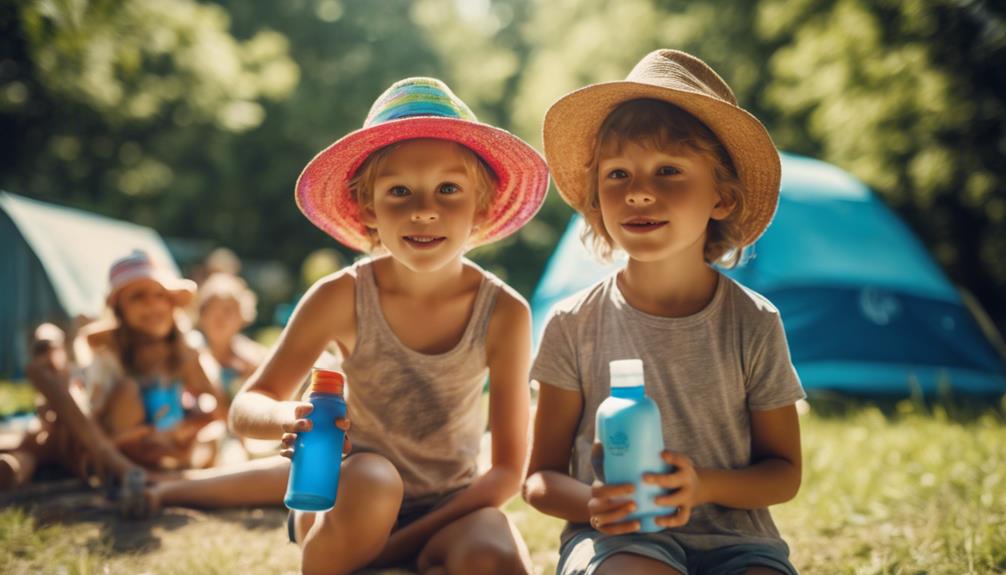
When choosing a summer camp, prioritize safety and sun protection for your child. Look for camps accredited by the American Camp Association to guarantee high standards. Confirm staff qualifications, focusing on first aid and CPR training. Make certain your child stays hydrated by encouraging regular water breaks and provide broad-spectrum sunscreen for protection from UV rays. Dress them in lightweight, protective clothing and hats. Discuss your child's specific needs with camp staff and maintain open communication about their well-being. There's much more to learn about keeping your child safe and healthy at camp this summer.
Key Takeaways
- Choose accredited camps with certified staff and a favorable camper-to-staff ratio for enhanced safety.
- Ensure daily sun safety practices, including applying SPF 30 sunscreen and encouraging hydration.
- Communicate specific health needs and emergency plans with camp staff before the camp starts.
- Provide lightweight, protective clothing and accessories like hats and sunglasses for UV protection.
Choosing a Safe Camp
When choosing a summer camp, you should prioritize safety by researching accreditation and checking staff qualifications. Look for camps accredited by the American Camp Association (ACA) to guarantee they meet high safety standards. Parent testimonials can provide additional insights into a camp's safety record, helping you make an informed decision.
It's essential to verify that the camp employs trained staff with appropriate certifications, especially in first aid and CPR. The staff-to-camper ratio plays a significant role in summer camp safety; ideally, this ratio shouldn't exceed 1:13. A lower ratio means more individualized attention and better supervision, reducing the risk of accidents.
Ask about the camp's thorough safety protocols, including emergency procedures for accidents, illnesses, and natural disasters. You should also inquire about daily safety practices, such as constant supervision during high-risk activities.
Confirm the camp has provisions for sun protection and hydration, as these are crucial during hot summer months. By taking these steps, you can feel more confident that your child will have a safe and enjoyable camp experience.
Preparing for Medical Needs
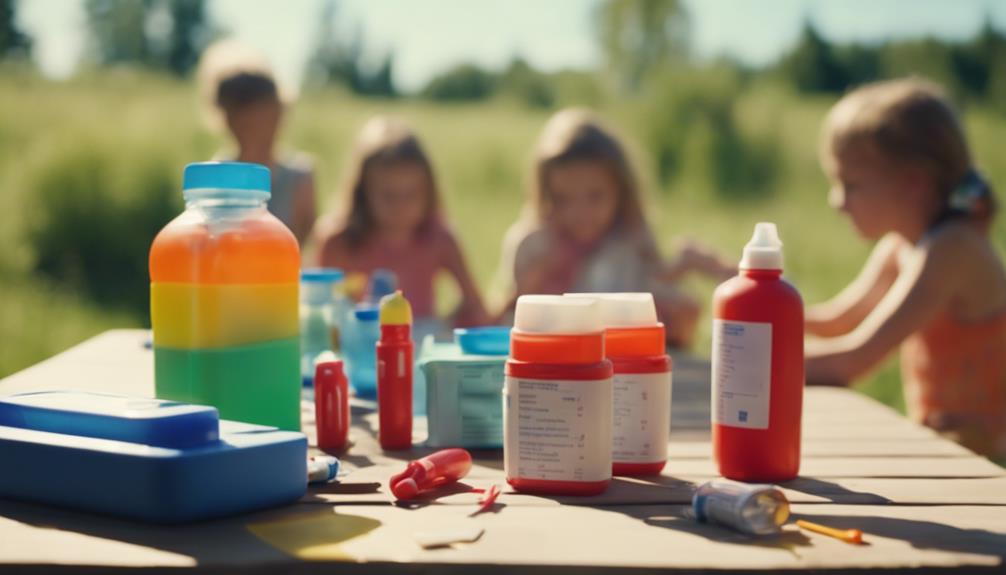
To guarantee your child's well-being at summer camp, provide detailed medical history that includes allergies, chronic conditions, and dietary restrictions. This information guarantees camp staff are well-informed and prepared to meet your child's needs.
- Complete all required medical forms.
- Include emergency contact information, like healthcare providers.
Your child's safety is paramount, so don't skip discussing specific health needs with the camp staff prior to arrival. This conversation allows for tailored support and accommodations during their stay.
Make certain the camp has qualified medical personnel on-site or access to healthcare facilities to handle emergencies effectively.
Understanding Staff Qualifications

Guaranteeing your child's safety at summer camp also involves understanding the qualifications of the staff who'll be caring for them. Camp counselors undergo a rigorous selection process that emphasizes camp safety and your child's safety. Each staff member must complete at least 35 hours of pre-camp training covering essential topics like CPR, first aid, child abuse prevention, and health observation.
To create a secure environment, all camp personnel undergo thorough background checks and drug screenings. The camps typically maintain a staff-to-camper ratio of 1:13, guaranteeing that groups consist of no more than 18 campers for maximum supervision. This low ratio allows counselors to focus on each child, promoting a safe and nurturing atmosphere.
Moreover, camp counselors are trained to model and promote core values such as Caring, Honesty, Respect, and Responsibility. These values foster a positive culture where children can thrive.
The qualifications of counselors and support personnel are regularly reviewed to verify they meet the camp's standards for child safety and emergency response. By understanding these qualifications, you can feel more confident in the safety and well-being of your child while they enjoy their summer camp experience.
Implementing Safety Protocols

When it comes to safety at summer camps, having clear emergency response procedures is essential.
You should also focus on daily safety practices and guarantee all staff are adequately trained to handle various situations.
Emergency Response Procedures
Camps need well-defined emergency response protocols that prepare staff and campers for incidents like accidents, illnesses, and natural disasters. These procedures guarantee that camp staff are trained, ready to act swiftly, and can manage situations effectively.
Regular safety drills are essential. They help everyone understand their roles and enhance overall safety awareness.
Here are a few key components of effective emergency response procedures:
- Trained camp staff: Guarantees all personnel know how to handle emergencies and administer first aid.
- Communication plan: Keeps parents informed with clear instructions on how to reach the camp during an emergency.
Additionally, it's critical that camps verify medical personnel can handle emergencies. They should have access to first aid supplies and maintain emergency contact information for each camper.
This preparedness not only enhances safety but also fosters a sense of security among parents, knowing their children are in capable hands. Always ask about these protocols before enrolling your child, as they play a fundamental role in guaranteeing a safe camp experience.
Daily Safety Practices
Effective daily safety practices at summer camps are essential for maintaining a secure environment and preventing accidents. You should guarantee that constant supervision is provided during high-risk activities, and that all activities are age-appropriate and aligned with each camper's physical abilities. This tailored approach not only enhances safety but also maximizes enjoyment.
Additionally, hygiene and sanitation need regular reviews, especially during meals and shared activities, to minimize illness. One of the most critical aspects is promoting sun safety. Provide easy access to sunscreen with an SPF of 30 or higher, and remind campers to apply it frequently. Encourage them to drink plenty of water throughout the day to stay hydrated and prevent heat-related illnesses.
Here's a quick reference table for daily safety practices:
| Safety Practice | Importance | Action Item |
|---|---|---|
| Supervision | Prevents accidents | Assign adult monitors |
| Age-Appropriate Activities | Guarantees safety and fun | Review activity suitability |
| Hygiene and Sanitation | Minimizes illness risk | Regular cleaning schedules |
| Sun Safety | Prevents sunburn and heat illnesses | Provide sunscreen and hydration breaks |
Staff Training Requirements
To guarantee a safe environment for campers, staff must complete at least 35 hours of pre-camp training covering critical topics like CPR, first aid, and child abuse prevention.
These staff training requirements are essential for effective child care, making sure that counselors are equipped to handle emergencies and support camper well-being.
Additionally, all camp staff undergo thorough background checks and drug screenings to maintain a trustworthy atmosphere for children. This diligence helps parents feel secure knowing their kids are in safe hands.
Here are some key aspects of staff training:
- Heat-related illness recognition: Staff learn to identify and respond to symptoms, keeping campers safe during hot weather.
- Hydration protocols: Training includes strategies to make certain campers stay properly hydrated during outdoor activities.
Daily Sun Safety Practices
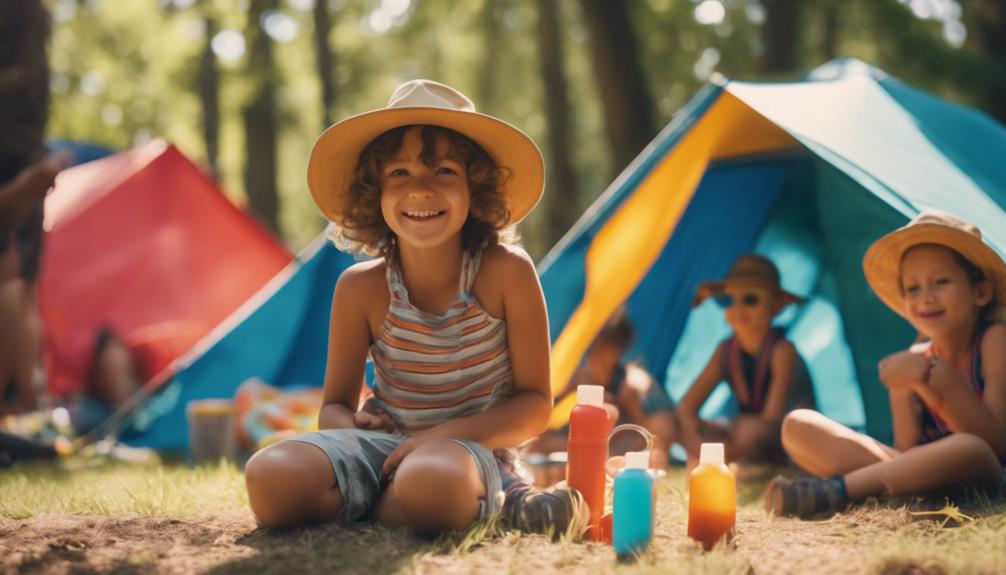
When you're out in the sun, applying sunscreen properly is vital to protect your skin.
Remember to keep everyone hydrated and dressed in lightweight, protective clothing to minimize UV exposure.
Let's explore these daily sun safety practices to guarantee a fun and safe summer camp experience.
Sunscreen Application Techniques
Applying broad-spectrum sunscreen with an SPF of at least 30 to all exposed skin 15-30 minutes before outdoor fun is crucial for protecting against harmful UV rays.
To make applying sunscreen easier and more effective, follow these tips:
- Choose the right sunscreen: Opt for a water-resistant formula that suits your child's skin type.
- Make it fun: Use a colorful sunblock stick that kids can apply themselves, empowering them to cover tricky spots like the back of the neck and ears.
Don't forget to pair sunscreen with protective clothing, such as wide-brimmed hats and UV-blocking sunglasses, to enhance their sun protection.
You can also pack travel-size sunscreen bottles in your child's bag to guarantee easy reapplication throughout their day at camp.
Educate your child about the importance of sun safety, emphasizing the risks of sunburn and long-term skin damage.
Hydration Reminders
Staying hydrated is essential for kids enjoying summer camps, especially during outdoor activities under the sun. Encourage your child to drink water regularly throughout the day, aiming for at least 5-7 ounces every 20-30 minutes. This practice helps prevent dehydration and keeps them energized for all the fun at day camp.
Packing multiple reusable water bottles is a smart move. This guarantees your child has easy access to hydration at all times. If plain water doesn't excite them, consider adding slices of fruit or using flavored water to make it more appealing. Promoting good hydration habits now will benefit them in the long run.
Keep an eye on your child's hydration levels by checking for signs of dehydration, such as dry mouth, fatigue, or dark-colored urine. Remind them to drink water immediately upon pick-up if they've been active in the heat.
Educating your child about the importance of staying hydrated, especially during hot weather, will help them understand the risks of heat-related illnesses. This knowledge not only keeps them safe but also fosters healthy habits that last a lifetime.
Protective Clothing Strategies
To keep your child safe from harmful UV rays at summer camp, prioritize protective clothing alongside hydration strategies. The right attire can greatly reduce sun exposure, ensuring your child enjoys outdoor activities without the risk of sunburn or long-term skin damage.
Consider these protective clothing strategies:
- Lightweight, long-sleeved shirts: Opt for dark-colored, breathable fabrics that provide better UV protection.
- Wide-brimmed hats: These can shield the face, ears, and neck from direct sunlight, offering added coverage.
When selecting clothing, look for items with a UPF (Ultraviolet Protection Factor) rating of 30 or higher for ideal defense against UV rays.
Layering clothing can also be beneficial, allowing your child to adjust to temperature changes while maintaining adequate coverage.
By emphasizing protective clothing, you can help your child stay safe and enjoy their summer camp experience to the fullest.
Encouraging Hydration
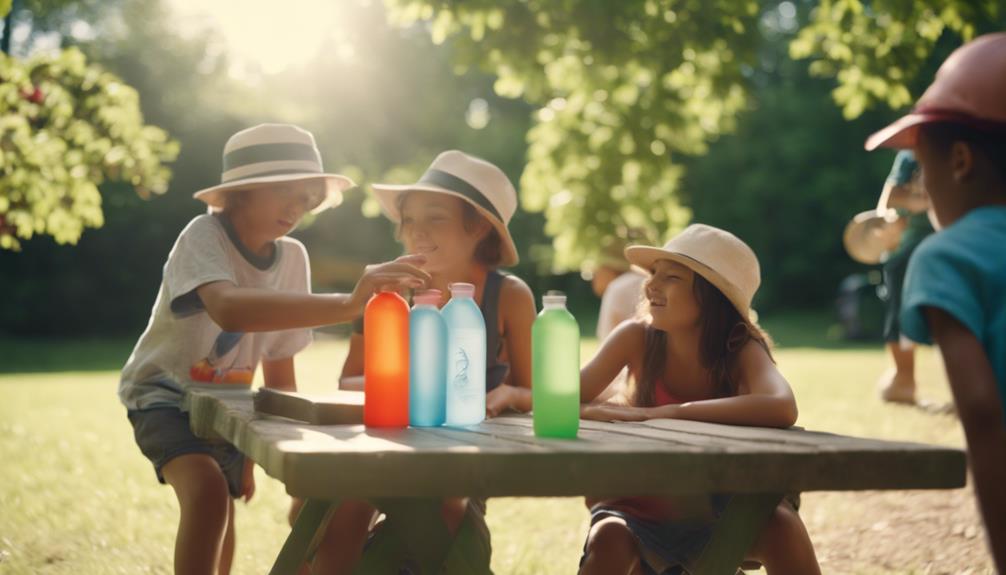
Encouraging kids to stay hydrated at summer camp is essential for their health and energy levels. Packing multiple reusable water bottles guarantees they have easy access to hydration throughout the day. Kids should take regular water breaks, especially during hot weather, to reduce the risk of dehydration.
To make hydration more appealing, consider adding fruit or flavor to their water. Educate your child on the signs of dehydration, such as thirst and fatigue, so they recognize when they need to drink. Additionally, remind them to hydrate immediately upon pick-up to replenish any fluids lost during camp activities.
Here's a quick visual guide to help you encourage hydration:
| Tip | Description |
|---|---|
| Pack Extra Bottles | Guarantee your child has enough water. |
| Flavor It Up | Add fruit to make water more fun! |
| Set Reminders | Remind them to drink regularly. |
Effective Sunscreen Usage

Applying sunscreen correctly is essential for protecting your child's skin from harmful UV rays during summer camp. To guarantee your child gets the best protection, follow these simple guidelines:
- Choose a broad-spectrum sunscreen with at least SPF 30 to guard against both UVA and UVB rays.
- Apply sunscreen generously to all exposed skin at least 15 minutes before outdoor activities, reapplying every two hours or more often if swimming or sweating.
Encouraging your child to take part in the sunscreen application process can make it a fun and engaging routine. Consider using colorful containers or stickers to motivate them.
Also, always check the expiration date and store sunscreen in a cool, shaded place to maintain its effectiveness.
Communicating With Camp Staff

Establishing open lines of communication with camp staff is vital for ensuring your child receives the support they need throughout their summer camp experience. Start by discussing your child's specific needs, including any allergies or health conditions. This helps staff provide adequate support and makes your child's well-being a top priority.
Make it a habit to request regular updates from camp counselors about your child's activities, behavior, and overall well-being. This keeps you informed and allows you to address any concerns proactively. You should also inquire about the camp's procedures for sharing feedback or raising issues, so you know how to communicate effectively if something arises.
Encourage your child to approach counselors whenever they need assistance. Ensuring your child knows how to ask for help can foster a sense of security and awareness of available support.
Finally, confirm the camp's emergency communication plan. Understanding how and when you'll be notified in case of incidents is essential for your peace of mind.
Frequently Asked Questions
What Is the Best Age to Send Kids to Summer Camp?
The best age to send your kids to summer camp is typically between 6 and 12. Consider their emotional maturity and readiness for separation, as individual development varies, influencing their overall camp experience.
Why Do Parents Send Their Child to Summer Camp?
Parents send their child to summer camp for socialization, independence, and personal growth. It's a chance for them to explore new interests, engage in physical activity, and have fun while you enjoy a break.
What Do Parents Look for in a Summer Camp?
When choosing a camp, you'll look for safety records, qualified staff, clear health policies, and engaging activities. Effective communication about your child's well-being and supervision during high-risk events are essential factors for your decision.
How to Stay Safe in the Summer for Kids?
As the sun blazes overhead, you can keep your kids safe by applying sunscreen, dressing them in protective clothing, ensuring they hydrate often, and teaching them to recognize heat exhaustion signs. Safety's a priority!
How Can I Ensure Sun Safety for My Kids at Summer Camp?
When sending your kids off to summer camp, it’s important to ensure their safety in the sun. Make sure they have sunscreen, hats, and sunglasses on the beach safety checklist kids. Teach them the importance of staying in the shade during peak hours and staying hydrated. Keep them safe and protected from the sun’s harmful rays.
Conclusion
As you navigate the summer camp landscape, think of yourself as a lighthouse guiding your child through safe shores.
By choosing a camp that prioritizes safety, preparing for their medical needs, and fostering daily sun safety practices, you can guarantee their summer is filled with fun, not sunburns.
Stay in touch with camp staff, and encourage hydration and sunscreen use.
With your vigilant support, your child can shine brightly while staying safe under the summer sun.
-

 Vetted4 months ago
Vetted4 months ago15 Best Tanning Accelerators for a Sun-Kissed Glow This Summer
-
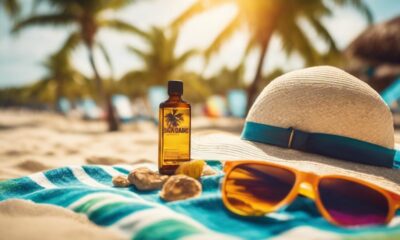
 Vetted4 months ago
Vetted4 months ago15 Best Tanning Oils for a Perfect Sun-Kissed Glow in 2024
-

 Vetted4 months ago
Vetted4 months ago15 Best Sun Tanning Products for a Gorgeous Glow This Summer
-

 Sun Protection4 months ago
Sun Protection4 months agoHow to Protect Your Skin Without Staying Indoors All Day
-

 Sun Protection4 months ago
Sun Protection4 months ago10 Sun Protection Myths Debunked!
-
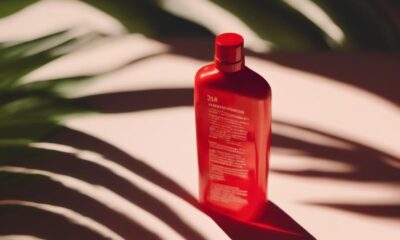
 Sun Protection4 months ago
Sun Protection4 months agoWhat Dermatologists Wish You Knew About Sunburns
-

 Sun Protection4 months ago
Sun Protection4 months agoThe Best Sun Protection Routine for Your Skin Type
-

 Vetted4 months ago
Vetted4 months ago15 Best Fake Tanning Lotions for a Sun-Kissed Glow All Year Round









